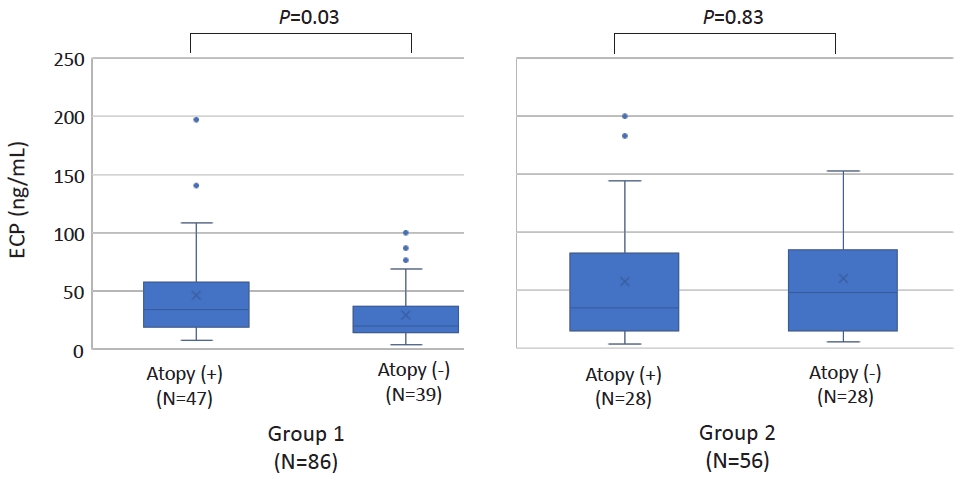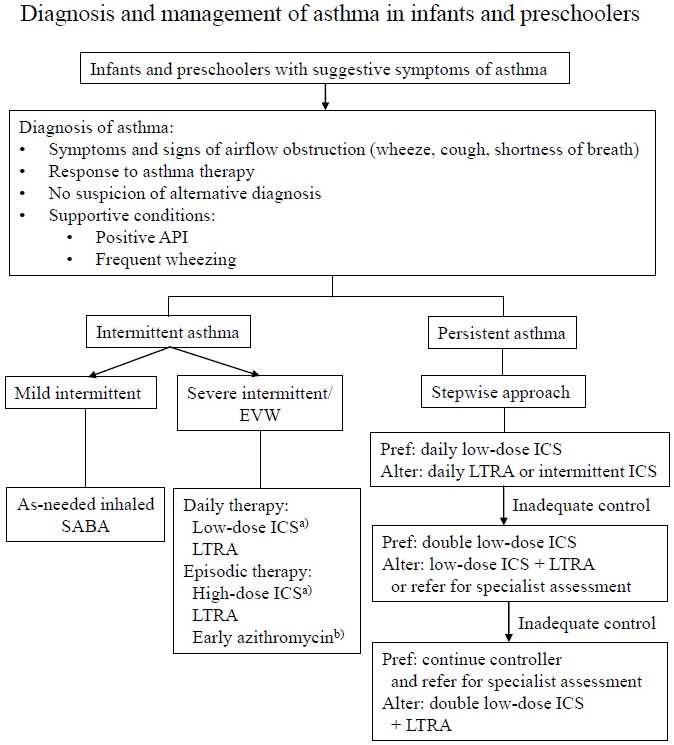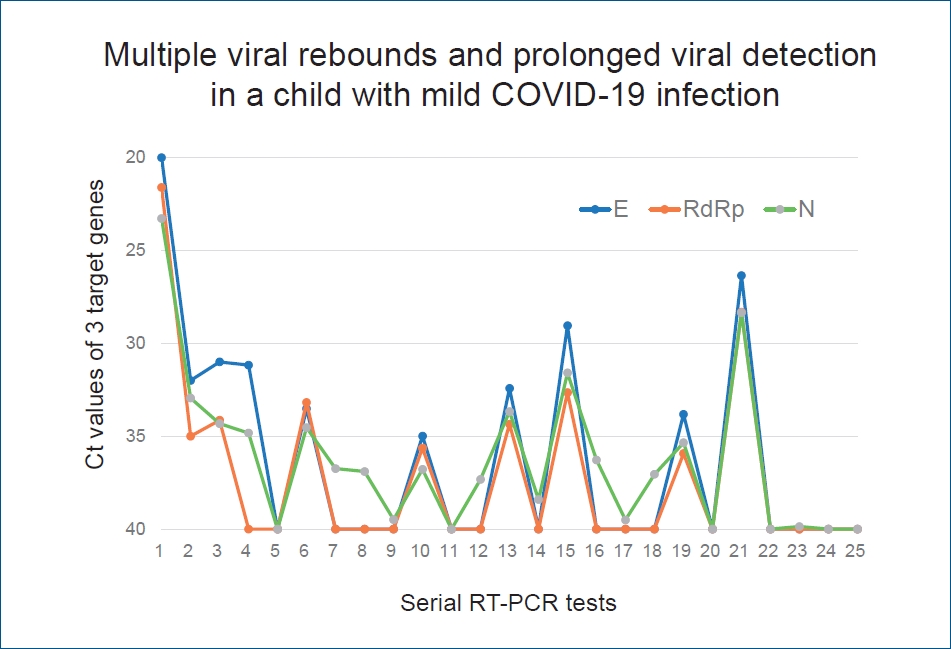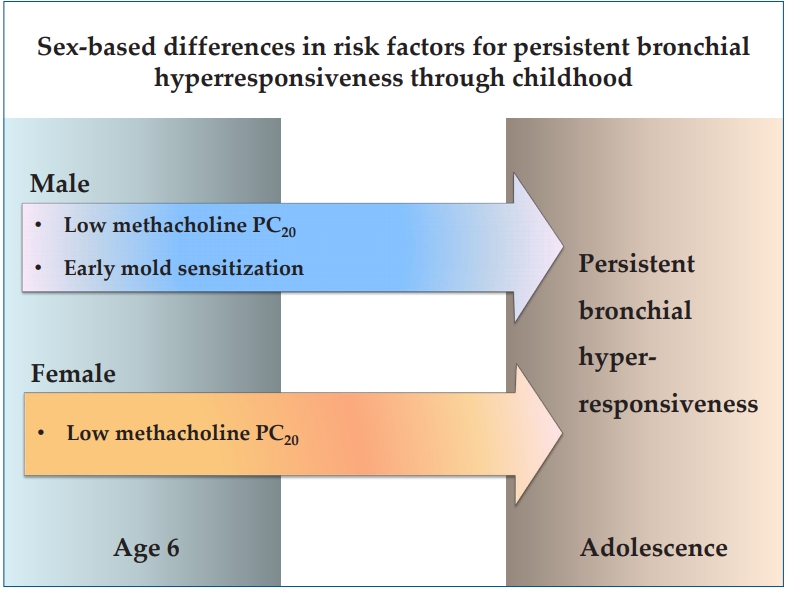Search
- Page Path
-
- HOME
- Search
- Letter to the Editor
- Allergy
- Increased serum eosinophilic cationic protein in children with nonspecific chronic cough
- Young Hwan Kim, Yoon Young Jang, Jieun Jeong, Hai Lee Chung
- Clin Exp Pediatr. 2023;66(10):455-457. Published online September 14, 2023
-

- Original Article
- Infection
- Clinical characteristics of pediatric patients infected with SARS-CoV-2 versus common human coronaviruses: a national multicenter study
- In Suk Sol, Eun Lee, Hyeon-Jong Yang, Yong Ju Lee, Hye Yung Yum, Mi-Hee Lee, Mi Ae Chu, Hui Jeong Moon, Hyo-Bin Kim, Ju Hee Seo, Jung Yeon Shim, Ji Young Ahn, Yoon Young Jang, Hai Lee Chung, Eun Hee Chung, Kyunghoon Kim, Bong-Seong Kim, Cheol Hong Kim, Yang Park, Meeyong Shin, Kyung Suk Lee, Man Yong Han, Soo-Jong Hong, Eun Kyeong Kang, Chang Keun Kim; on behalf of The Pneumonia & Respiratory Disease Study Group of Korean Academy of Pediatric Allergy and Respiratory Disease
- Clin Exp Pediatr. 2023;66(3):134-141. Published online December 22, 2022
-

Question: The clinical differences between severe acute respiratory syndrome coronavirus-2 (SARS-CoV-2) and human coronaviruses (HCoV) in children remain unknown.
Finding: This study compared the clinical findings of children infected with SARS-CoV-2 versus HCoV. Its findings suggest that children and adolescents with SARS-CoV-2 have a milder clinical course than those with HCoV.
Meaning: The clinical course of children and adolescents with SARS-CoV-2 should be closely monitored during the coronavirus disease 2019 pandemic.
- Review Article
- Allergy
- Diagnosis and management of asthma in infants and preschoolers
- Hai Lee Chung
- Clin Exp Pediatr. 2022;65(12):574-584. Published online April 19, 2022
-

· Asthma in infants and preschoolers involves heterogeneous phenotypes.
· Asthma diagnosis is based on symptom patterns, therapeutic responses, and the presence of risk factors with careful consideration of differential diagnosis.
· Daily inhaled corticosteroid therapy remains the most effective strategy for managing persistent asthma symptoms irrespective of phenotype.
· Future research, including genetic and molecular studies, is needed to develop a clear definition of asthma and personalized therapeutic approaches.
- Original Article
- Infection
- Viral load and rebound in children with coronavirus disease 2019 during the first outbreak in Daegu city
- Mi Ae Chu, Yoon Young Jang, Dong Won Lee, Sung Hoon Kim, Namhee Ryoo, Sunggyun Park, Jae Hee Lee, Hai Lee Chung
- Clin Exp Pediatr. 2021;64(12):652-660. Published online October 12, 2021
-

Question: What is the natural course of viral load in children with coronavirus disease 2019 (COVID-19)?
Finding: A significant number of patients still had a relatively high viral load once clinically asymptomatic. Nearly half of the patients experienced viral rebound, which contributed to prolonged viral detection in their respiratory specimens.
Meaning: Further studies are needed to determine the clinical significance of viral rebound in asymptomatic or mild pediatric cases of COVID-19.
- Allergy
- Sex-based differences in factors associated with bronchial hyperresponsiveness in adolescents with childhood asthma
- Young Hwan Kim, Yoon Young Jang, Jieun Jeong, Hai Lee Chung
- Clin Exp Pediatr. 2021;64(5):229-238. Published online January 14, 2021
-

Question: What factors are associated with bronchial hyperresponsiveness (BHR) in adolescents with childhood asthma?
Finding: Age, mold sensitization, and increased eosinophil count were associated with BHR in boys versus a reduced forced expiratory volume in 1 second/forced vital capacity ratio in girls. Early mold sensitization was a risk factor for persistent BHR in boys only.
Meaning: Sex-specific differences were observed in the factors associated with BHR in adolescents.
- Neonatology (Perinatology)
- Neuroprotective effects of erythropoietin against hypoxic injury via modulation of the mitogen-activated protein kinase pathway and apoptosis
- Ji Eun Jeong, Jae Hyun Park, Chun Soo Kim, Sang Lak Lee, Hai Lee Chung, Woo Taek Kim, Eun Joo Lee
- Clin Exp Pediatr. 2017;60(6):181-188. Published online June 22, 2017
-
Purpose Hypoxic-ischemic encephalopathy is a significant cause of neonatal morbidity and mortality. Erythropoietin (EPO) is emerging as a therapeutic candidate for neuroprotection. Therefore, this study was designed to determine the neuroprotective role of recombinant human EPO (rHuEPO) and the possible mechanisms by which mitogen-activated protein kinase (MAPK) signaling pathway including extracellular signal-regulated kinase (ERK1/2), JNK, and p38 MAPK is modulated in...
- Review Article
- Asthma in childhood: a complex, heterogeneous disease
- Hai Lee Chung
- Clin Exp Pediatr. 2011;54(1):1-5. Published online January 31, 2011
-
Asthma in childhood is a heterogeneous disease with different phenotypes and variable clinical manifestations, which depend on the age, gender, genetic background, and environmental influences of the patients. Several longitudinal studies have been conducted to classify the phenotypes of childhood asthma, on the basis of the symptoms, triggers of wheezing illness, or pathophysiological features of the disease. These studies have...
- Original Article
- The neuroprotective effect of recombinant human erythropoietin via an antiapoptotic mechanism on hypoxic-ischemic brain injury in neonatal rats
- Moon Sun Kim, Yoo Kyung Seo, Hye Jin Park, Kye Hyang Lee, Kyung Hoon Lee, Eun Jin Choi, Jin Kyung Kim, Hai Lee Chung, Woo Taek Kim
- Clin Exp Pediatr. 2010;53(10):898-908. Published online October 31, 2010
-
Purpose The neuroprotective effects of erythropoietin (EPO) have been recently shown in many animal models of brain injury, including hypoxic-ischemic (HI) encephalopathy, trauma, and excitotoxicity; however, limited data are available for such effects during the neonatal periods. Therefore, we investigated whether recombinant human EPO (rHuEPO) can protect against perinatal HI brain injury via an antiapoptotic mechanism.
Methods The left carotid artery was ligated...
- Taurine exerts neuroprotective effects via anti-apoptosis in hypoxic-ischemic brain injury in neonatal rats
- Ji Eun Jeong, Tae Yeol Kim, Hye Jin Park, Kye Hyang Lee, Kyung Hoon Lee, Eun Jin Choi, Jin Kyung Kim, Hai Lee Chung, Eok Su Seo, Woo Taek Kim
- Clin Exp Pediatr. 2009;52(12):1337-1347. Published online December 15, 2009
-
Purpose : Taurine (2-aminoethanesulfonic acid) is a simple sulfur-containing amino acid. It is abundantly present in tissues such as brain, retina, heart, and skeletal muscles. Current studies have demonstrated the neuroprotective effects of taurine, but limited data are available for such effects during neonatal period. The aim of this study was to determine whether taurine could reduce hypoxic-ischemic (HI) cerebral... -
- Neuroprotective effects of resveratrol via anti-apoptosis on hypoxic-ischemic brain injury in neonatal rats
- Jin Young Shin, Min Ae Seo, Eun Jin Choi, Jin Kyung Kim, Eok Su Seo, Jun Hwa Lee, Hai Lee Chung, Woo Taek Kim
- Clin Exp Pediatr. 2008;51(10):1102-1111. Published online October 15, 2008
-
Purpose : Resveratrol, extracted from red wine and grapes, has an anti-cancer effect, an antiinflammatory effect, and an antioxidative effect mainly in heart disease and also has neuroprotective effects in the adult animal model. No studies for neuroprotective effects during the neonatal periods have been reported. Therefore, we studied the neuroprotective effect of resveratrol on hypoxic-ischemic brain damage in neonatal... -
- Case Report
- A case of lethal kwashiorkor caused by feeding only with cereal grain
- Hyun Ju Lee, Kyung Hye Km, Hye Jin Park, Kye Hyang Lee, Gyeong Hoon Lee, Eun Jin Choi, Jin Kyung Kim, Hai Lee Chung, Woo Taek Kim
- Clin Exp Pediatr. 2008;51(3):329-334. Published online March 15, 2008
-
Kwashiorkor is a syndrome of severe protein malnutrition, which manifests itself in hypoalbuminemia, diarrhea, dermatitis, and edema. It can be life-threatening due to associated immune deficiency and an increased susceptibility to infections. Kwashiorkor should be treated early with nutritional support and the control of infection. Dilated cardiomyopathy may develop during the treatment and in such cases a poor prognosis is... -
- Original Article
- Neuroprotective effects of geneticin (G418) via apoptosis in perinatal hypoxic-ischemic brain injury
- Mi Ju, Hyun Ju Lee, Sun Ju Lee, Eo Su Seo, Hye Jin Park, Kye Yang Lee, Gyeong Hoon Lee, Eun Jin Choi, Jin Kyung Kim, Jong Won Lee, Hai Lee Chung, Woo Taek Kim
- Clin Exp Pediatr. 2008;51(2):170-180. Published online February 15, 2008
-
Purpose : Some antibiotics were known to exert neuroprotective effects in the animal model of hypoxic-ischemic (H-I) brain injury, but the mechanism is still unclear. A recent study reported that geneticin (G418), an aminoglycoside antibiotic, increased survival of human breast cancer cells by suppressing apoptosis. We investigated the neuroprotective effects of systemically administrated geneticin via anti-apoptosis following the H-I brain... -
- The neuroprotective effect of mycophenolic acid via anti-apoptosis in perinatal hypoxic-ischemic brain injury
- Ji Young Kim, Seung Ho Yang, Sun Hwa Cha, Ji Yeun Kim, Young Chae Jang, Kwan Kyu Park, Jin Kyung Kim, Hai Lee Chung, Eok Su Seo, Woo Taek Kim
- Clin Exp Pediatr. 2007;50(7):686-693. Published online July 15, 2007
-
Purpose : Mycophenolic acid (MPA), the active metabolite of mycophenolate mofetil (MMF), is a potent inhibitor of inosine-monophosphate dehydrogenase (IMPDH), a new immunosuppressive drug used. It was reported that MPA protected neurons after excitotoxic injury, induced apoptosis in microglial cells. However, the effects of MPA on hypoxic-ischemic (HI) brain injury has not been yet evaluated. Therefore, we examined whether MPA... -
- Review Article
- Clinical significance of serum IgE
- Hai Lee Chung
- Clin Exp Pediatr. 2007;50(5):416-421. Published online May 15, 2007
-
Many previous studies have proved that human allergic disease resulted from the formation of antibodies belonging to a unique immunoglobulin isotype termed immunoglobulin E (IgE). Most of IgE- producing plasma cells are found in the lymphoid tissue associated with the gastrointestinal and respiratory tracts. IgE may be found free in the mucosal secretions of these tissues, bound to local mast... -
- Original Article
- The Effectiveness of Intravenous Immunoglobulin for Clinically Suspected Neonatal Sepsis
- Hyun Jung Na, Ji Young Kim, Gyeong Hoon Lee, Jun Hwa Lee, Eun Jin Choi, Jin Kyung Kim, Hai Lee Chung, Woo Taek Kim
- Clin Exp Pediatr. 2005;48(11):1187-1192. Published online November 15, 2005
-
Purpose : The purpose of this study is to determine the effectiveness of intravenous immunoglobuin (IVIG) administration in fullterm neonates having clinically suspected neonatal sepsis. Methods : Forty full-term neonates admitted to the neonatal intensive care unit with clinically suspected neonatal sepsis, who had at least two positive diagnostic criteria were enrolled. Twenty neonates were enrolled into the IVIG arm and... -
- Case Report
- A Life-Threatening Case of Tubular Esophageal Duplication Complicated with Aneurysm of the Aorta
- Yeon Kyung Jung, Gyeong Hoon Lee, Hai Lee Chung, Ki Sung Park, Kyung-Jae Jung, Chang Ho Cho
- Clin Exp Pediatr. 2005;48(6):655-659. Published online June 15, 2005
-
Esophageal duplication cysts are rare congenital lesions that occur as a result of a failure in the tubulation of the esophagus. They are most frequently single, tubular, or cystic. They may cause compressive symptoms or may be discovered incidentally on chest radiographs. They become symptomatic when complications develop. Symptoms often are related to the location of the duplication; esophageal lesions... -
- Original Article
- Cardioprotective Effects of Minocycline in Rat Myocardiac Cell Culture Induced by Hypoxia
- Bum Seok Yang, Hye Jin Park, Hong Tae Kim, Jong Won Lee, Dong Suk Lee, Un Seok Nho, Hai Lee Chung, Woo Taek Kim
- Clin Exp Pediatr. 2004;47(6):685-690. Published online June 15, 2004
-
Purpose : Minocycline appears to reduce the mortality rate of patients with myocardial infarction. Therefore, the cardioprotective effects of minocycline through reduction of apoptosis were studied in a rat myocardiac cell culture induced by hypoxia. Methods : Cultured cells from the hearts of Sprague-Dawley rats were divided into two sets of groups : normoxia groups treated with 5% O2 and... -
- Cytokines in Neonatal Sepsis
- Hye Jin Park, So Yeon Kim, Jun Hwa Lee, Eun Jin Choi, Jin Kyung Kim, Sang Gyung Kim, Hai Lee Chung, Woo Taek Kim
- Clin Exp Pediatr. 2004;47(5):515-520. Published online May 15, 2004
-
Purpose : Maternal premature rupture of membrane(PROM) over 24 hours is a risk factor in neonatal sepsis and a main cause of administration to neonatal intensive care unit. Levels of proinflammatory cytokines were studied to diagnose and treat early in newborn infants with sepsis and with a history of maternal PROM. Methods : Interleukin-1β(IL-1β), Interleukin-6(IL-6), Interleukin-8(IL-8), and tumor necrosis factor-α(TNF-α) were... -
- Neuroprotective Effects of Minocycline in Rat Brain Cortical Cell Culture Induced by Hypoxia
- Kyung A Ha, Bum Seok Yang, Jin Kyung Kim, Hong Tae Kim, Sung Jin Ha, Jong Won Lee, Hai Lee Chung, Woo Taek Kim
- Clin Exp Pediatr. 2003;46(11):1101-1106. Published online November 15, 2003
-
Purpose : In vivo, minocycline appears to be neuroprotective. Thus, the neuroprotective effects of minocycline were studied in a rat brain cortical cell culture induced by hypoxia. Methods : Cultured cells from the brains of Sprague-Dawley rats were divided into two sets of groups : normoxia groups treated with 5% CO2 and hypoxia groups treated with 1% CO2. After several... -
- Case Report
- A Case of Raine Syndrome
- Hye Jin Park, Jeong Jin Lee, Jeong Sik Seo, Hyo Jin Kim, Je Yong Choi, Jun Hwa Lee, Un Seok Nho, Hai Lee Chung, Woo Taek Kim
- Clin Exp Pediatr. 2003;46(1):91-94. Published online January 15, 2003
-
Raine syndrome was described as an unknown syndrome in 1989. It is characterized by severe craniofacial anomalies with microcephaly, hypoplastic nose, depressed nasal bridge, exophthamos/protosis, gum hypertrophy, cleft palate, low-set ears, small mandible, narrow chest, wide cranial sutures and choanal atresia or stenosis, by generalized osteosclerosis with subperiosteal thickening of ribs, clavicles and diaphysis of long bones, and by intracranial... -
- A Case of Scoliosis Due to a Foreign Body(Pencil) in the Colon
- Jeong Sik Seo, Sun Mi Chung, Eun Jin Choi, Jin Kyung Kim, Un Seok Nho, Hai Lee Chung, Dae Hyun Joo, Woo Taek Kim
- Clin Exp Pediatr. 2002;45(11):1417-1421. Published online November 15, 2002
-
Scoliosis describes a lateral curvature of the spine and is often associated with cosmetic and functional impairments due to severe deformity of the spine. The incidence of adolescent scoliosis is 2-4% of children between 10 and 16 years of age. Eighty five percent of them are idiopathic, in which the most common type of scoliosis is right side-bending. In addition,... -
- Original Article
- Clinical Features of Food Protein-Induced Enterocolitis Syndrome
- Jeong Sik Seo, Hai Lee Chung
- Clin Exp Pediatr. 2001;44(7):758-763. Published online July 15, 2001
-
Purpose : Food protein-induced enterocolitis syndrome(FPIES) is a symptom complex of severe vomiting and diarrhea which is known as a food-related gastrointestinal hypersensitivity disorder without evidence of IgE-mediated sensitivity. We described the clinical characteristics of FPIES in young infants. Methods : Twenty-eight patients, aged 7 to 120 days, were included who were diagnosed as FPIES by clinical criteria and food challenges.... -
- Case Report
- A Case of Trichosporon beigelii Pneumonia in a Boy with Normal Immunological Status
- Hyun Hee Kim, Hai Lee Chung, in Bok Hwang, Cheal Woo Ko
- Clin Exp Pediatr. 2000;43(2):300-305. Published online February 15, 2000
-
Invasive diseases caused by Trichosporon beigelii are rare, usually fatal, opportunistic infections that occur exclusively in immunocompromised patients. This fungus has been known to produce cutaneous involvement in immunocompetent hosts, and is rarely reported to cause systemic disease in patients with cardiac valve replacement. In this report, we described a case of invasive Trichosporon beigelii pneumonia in a 9-year-old boy... -
- Original Article
- The Significance of Increased Circulating Intercellular Adhesion Molecule 1(cICAM-1) in Neonatal Sepsis
- Hai Lee Chung, Eun Jung Park, Young Ho An, Jin Bok Hwang, Chang Ho Han, Young Dae Kwon, Sang Gyoung Kim
- Clin Exp Pediatr. 1997;40(12):1651-1659. Published online December 15, 1997
-
Purpose : The early and efficient diagnosis of neonatal sepsis still remains a difficult task. Reliable laboratory test is not available yet and treatment is mainly based on the physical appearance of infants. And high number of negative blood cultures in cases of clinically diagnosed sepsis further emphasize the need for a more reliable index for early diagnosis. Intercellular adhesion molecule 1(ICAM-1) has been... -
- Case Report
- A Case of Granular Acute Lymphoblastic Leukemia with t(5p;5p) Arising in Down Syndrome Infant
- Soon Ja Lee, Young Ho An, Hai Lee Chung
- Clin Exp Pediatr. 1997;40(3):417-422. Published online March 15, 1997
-
Granular lymphoblast which is characterized by the presence of clearly defined azurophilic cytoplasmic granules are a relatively uncommon finding and indicate a negative impact on prognosis of childhood ALL. Granular ALL is more common in FAB L2 cases but there is no significant difference by immunophenotype and no specific cytogenetic abnormality correlated with clinical significance of granular ALL has been reported. We present a case... -
- Original Article
- A Follow-Up Study of Intractable Diarrhea in Early Infancy: Clinical Features of Cow's Milk Allergy and Cow Milk-Sensitive Enteropathy
- Young Rak Kwon, Young Ho Ahn, Jin Bok Hwang, Chang Ho Han, Hai Lee Chung, Young Dae Kwon
- Clin Exp Pediatr. 1995;38(11):1515-1524. Published online November 15, 1995
-
Purpose : The multiplicity of poorly defined illnesses and the variability of clinical and laboratory features elicited by milk ingestion in sensitized infants has made it difficult to differentiate them from the more common forms of cow milk intolerance. Following up the cases of intractable diarrhea in early infancy(illI), We investigated the clinical features of cow's milk allergy(CMA) and cow... -
- A Clinical Evaluation of the Gastrofiberscopy Studies in Children
- Jung Ah Park, Young Ho Ahn, Jin Bok Hwang, Chang Ho Han, Hai Lee Chung, Young Dae Kwon, Jae Bok Park
- Clin Exp Pediatr. 1995;38(11):1498-1505. Published online November 15, 1995
-
Purpose : This study aimed to provide, as basic material, the experience of gastrofiberscopy in children and the clinical significance of Helicobacter pylori(H. pylori) infection in pediatric gastrointestinal disease. Methods : The objects were 99 patients(male 49, female 50) who underwent gastrofiberscopic examination in case of endoscopic indication at department of pediatrics of Taegu Hyosung Catholic University Hospital from March 1993... -
- Intractable Diarrhea in Early Infancy : Clinical Features on Admission and A Nutritional Management
- Jong Won Shin, Kyung Won Hwang, Young Ho Ahn, Jin Bok Hwang, Chang Ho Han, Hai Lee Chung, Young Dae Kwon
- Clin Exp Pediatr. 1995;38(7):936-945. Published online July 15, 1995
-
Purpose : We studied to assess the value of clinical findings on admission in screening of intractable diarrhea in early infancy(IDI) and the efficiency of early trial of semi-elemental form-ula (protein hydrolysate) as a nutritional management in IDI. Methods : We carried out a retrospective review of medical records of twenty-eight early infants with diarrhea and malnutrition who were diagnosed as... -
-

-
-
Impact Factor3.2
-
8.02023CiteScore94th percentilePowered by
-









